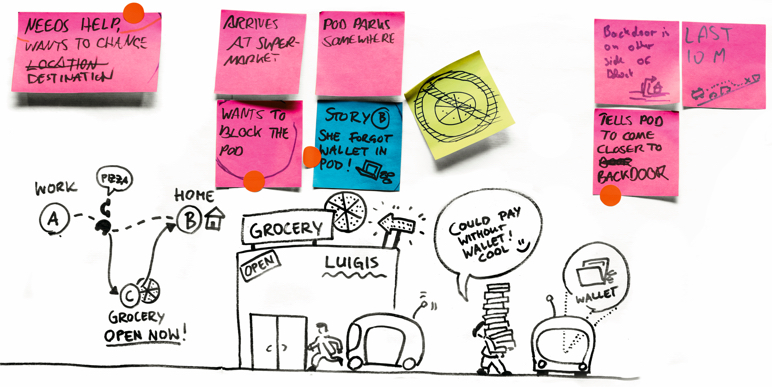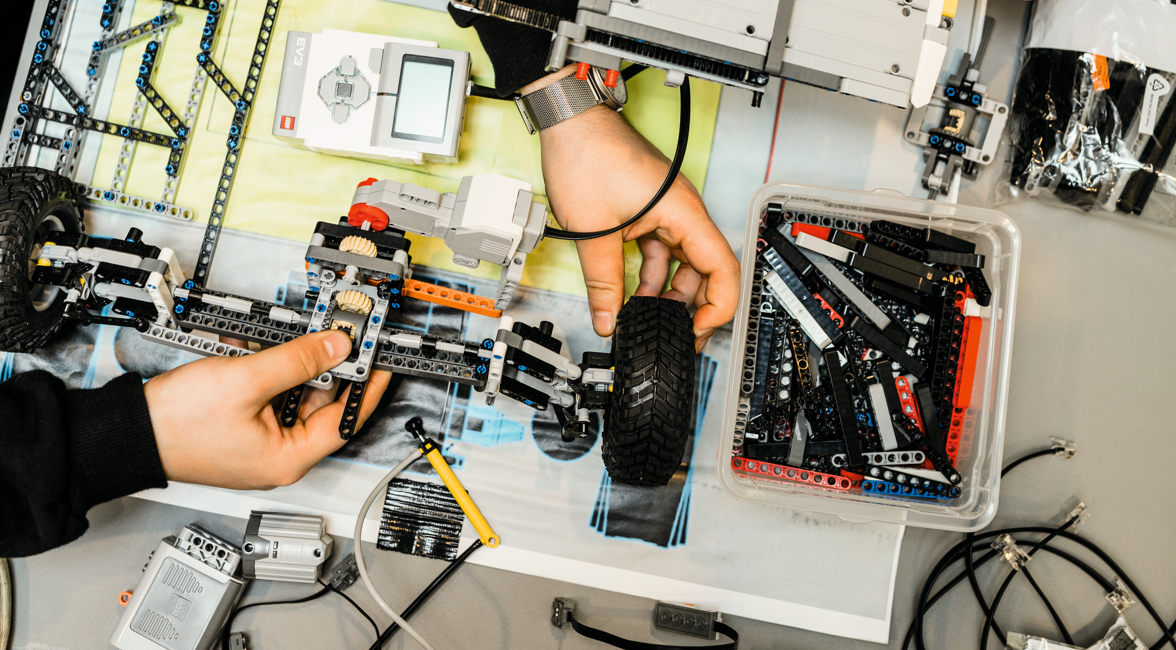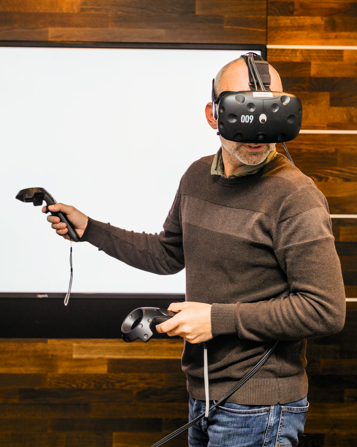Just outside Berlin, some 100 digital experts and designers are researching the mobility solutions of tomorrow. But above all, they are trying out a pioneering new form of collaboration. We paid them a visit.
In the beginning, there was just a name: USP, the acronym for Urban Shared Pod. That was the goal – to develop a mobile structure that people could share and that was unlike anything ever seen before. The rest was TBD – to be discussed. The first thing the members of “Team USP” did was to make a list. With questions such as, does our pod solve people’s problems? Or, is our pod fun? Does it make everyday life easier for users? Does it inspire them?
Some one hundred designers and user experience experts, software developers and IT professionals are working on tomorrow’s mobility at the Volkswagen Group Future Center Europe, a glass and concrete building in a prime location in Potsdam, state capital of Brandenburg. One way or another, everyone in the automotive industry seems to be doing that at the moment, but these particular colleagues can also claim another USP – their unique selling point. Their focus is not so much on developing new sales products, but rather on trying out new perspectives. “The very first question we ask is, what do users want?” Mark Bergold, Lead UX Design, says.

Take a great leap forward and then follow the trail back to the present: Working sketch for Vehicle Design at the Volkswagen Group Future Center Europe on the banks of the Tiefer See lake in Potsdam.
That might sound like stating the obvious, but it is a genuine first in the history of the tradition-rich Group. Until now, automobile production was usually dictated by technological innovations. The design and IT departments were given concrete tasks to complete. However, the digital age calls for a new work culture. The mission is to come up with swift and flexible solutions tailored to customer needs. To design digital offerings capable of learning and adapting. “Our aim is to solve more customer problems and execute fewer tasks. We work in agile interdisciplinary teams where the hierarchies are flat and there is no room for autocrats. And we take feedback from our users on board as early and as often as possible,” says Alisa Goikhman, UX Design Concepter for smart interfaces. The trailblazers at the Future Center call this philosophy “human thinking.” There is only one focus: people. Their needs. Their well-being. And what Volkswagen can do to strengthen people’s confidence in new mobility solutions.
Team USP started with two four-week sprints at the end of 2016. Armed with their list of questions, the team members took to the streets and asked Berlin passers-by for answers. Then they got down to evaluating the responses: user journeys took shape in order to better understand customer needs during the various stages of life. In the fourth week, the team built its first pod, complete with a wooden chassis and padded seats, in the workshop. “Here at the Future Center, we make most of our stuff ourselves,” says Exterior Designer Marian Hilgers. The center has experts on just about everything, everything is possible, and everything is in motion. At the Volkswagen Design Center Potsdam, the predecessor to the Future Center opened in 2016, demonstration studies had to be practically production-ready models. As far as the Urban Shared Pod is concerned, the provisional character typical of prototypes is the order of the day.
“We are able to develop outside the series processes. That gives us more flexibility. And more openness to unusual impulses.”
Aaron Post, Interior Designer

User journey as a working basis: the mobility solutions must be designed to solve concrete everyday problems.
Team USP gets feedback from users at the end of every development step – initially as a digital experience with virtual reality headsets, and later “live” in the Wizard Bus, where testers can try out the USP complete with all services. The bus has a smart way of simulating autonomous driving. The passengers are unaware there is in fact a driver, because what they see is images of the view through the windscreen as taken by a camera and projected on a screen, creating a remarkably realistic sense of what autonomous driving is like.
It did not take the team long to agree on the mobility concept. “Ride hailing is a sharing concept that suits plenty of users,” says Inae Song, UX Design Concepter. The USP is ordered by app, collects users at their pick-up point and lets them ride for as long as they want. During the ride, passengers can order food or “coffee to drive” for delivery to the USP, or they can book concert tickets via the screen. Or they can listen to their favorite kind of music – entertainment, karaoke or meditation.

All their own work: the teams use Lego sets or virtual reality rooms to realize their projects.
On our visit, Team USP was in the middle of a sprint to optimize digital apps to suit user needs and develop intelligent payment models and networks. The project approach is iterative. Each result is continuously improved. “One of our advantages is that we are able to develop outside the series processes,” says Aaron Post, Interior Designer. “That gives us more flexibility. And possibly more open to unusual impulses.”
The Future Center mindset is evidently catching on. Other centers in Beijing and California have started working on a better understanding and evaluation of customer needs in the key markets of China and North America. And Future Center experts have been criss-crossing markets and continents since 2016, organizing workshops that help others to experience and apply human thinking. Most of the feedback is positive, sometimes even surprising, and always fresh and enriching.

“We work in agile teams where there is no room for autocrats. And we get as much feedback as possible from our users.”
Alisa Goikhman, UX Design Concepter
The Future Center also breaks new ground in its recruiting. The majority of employees come from international backgrounds, are highly trained and under 35. Only a few are classic automobile professionals, some do not even have a driver’s license. What tempted them to come here? The close proximity to Berlin. The good team play lead by Nanna Nietiedt, Ulrike Müller, and Peter Wouda. A smart work-life balance. But above all, the exhilarating feeling that comes with playing a part in moving a global group forward.
And if their work culminates in a cutting-edge product – so much the better. Sedric, a self-driving car with no pedals or steering wheel that was developed in cooperation with Group Research, caused quite a stir at the motor shows in Geneva and Frankfurt in 2017. Users can summon the car at the touch of OneButton, a remote that is smaller than a car key.
Sedric has made people sit up and take notice of the Future Center – not just in the Group, but also across the automotive industry. Since then, hardly a week passes without people from various brands swapping knowledge and ideas about the future – the Potsdam way.
